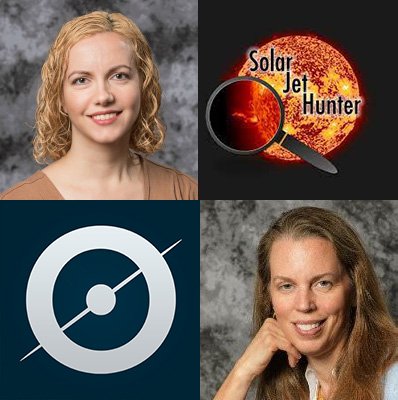UMN solar astrophysics research to get a boost from citizen science

The latest Zooniverse citizen science project called “Solar Jet Hunter” will help benefit a small research team led by members of the School of Physics and Astronomy: former postdoctoral researcher Dr. Sophie Musset, Associate Professor Lindsay Glesener, and Professor Lucy Fortson.
Citizen scientists will use their personal computers to identify a solar jet eruption on the surface of the sun from a short movie made from a series of still images. Glesener says the effort will save years of work for astrophysicists who are hoping to identify as many solar jets from the sun as possible. Scientists will compile these jet images into a database that will help any astrophysicists who are trying to study this powerful, but still somewhat mysterious process.
Participants will help identify bursts of plasma coming off the Sun, called solar jets, in thousands of images captured over the last 11 years by NASA’s Solar Dynamic Observatory.“These solar jets are sort of like a million hydrogen bombs going off on the star that’s actually not that far away from us, so it is important that we try to understand more about how that happens,” Glesener said. So far, solar jets have eluded efforts to create machine learning software to identify them automatically, but they are relatively easy for human eyes to spot. This set of factors made them a good candidate for Zooniverse, which provides a platform for ordinary people to interact with real scientific data and to assist in real science.
Glesener also said that the University of Minnesota was the perfect place for solar research and citizen science to come together. “We have both the expertise in studying solar jets and the Zooniverse team here at the University of Minnesota,” Glesener said. “You can’t just throw some random images up on a website and expect that you're going to get the information from the citizen scientists that you need. It takes people who really know how to make it work.”
Lucy Fortson, a fellow University of Minnesota physics and astronomy professor and one of the founders of the Zooniverse platform, is one of those experts.
“While Zooniverse has been involved in all kinds of citizen science projects from the humanities to biology, this project brings us back to our astrophysics roots,” Fortson said. “Our partnership with NASA and the Adler Planetarium has expanded our capacity to take on important projects like this one and increased the acceptance of citizen science as a valid research methodology within the scientific community. This is real proof that citizen science has come of age as a research tool.”
In addition to Musset, Glesener, and Fortson, the Solar Jet Hunter international research team includes co-investigators Gregory Fleishman, a professor in the Center for Solar-Terrestrial Research at the New Jersey Institute of Technology; and Navdeep Panesar, a research scientist at Lockheed Martin Solar & Astrophysics Laboratory and Bay Area Environmental Research Institute. Other members of the team include Erik Ostlund, a Zooniverse web developer at the University of Minnesota; Suhail Alnahari, a data scientist in the University of Minnesota’s School of Physics and Astronomy; University of Minnesota graduate students Yixian Zhang and Charlie Kapsiak; Mariana Jeunon, graduate student at Catholic University of America in Washington, D.C.; and Paloma Jol, a master student at Leiden University in The Netherlands.
The Solar Jet Hunter citizen science project is funded by NASA under the Heliophysics Guest Investigators program, and has supported students under a U.S. National Science Foundation CAREER grant.